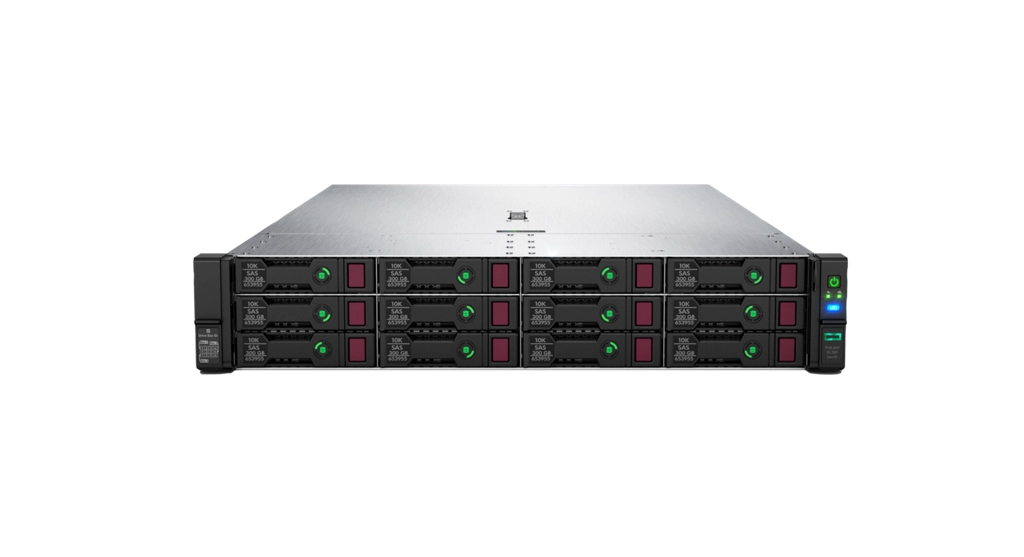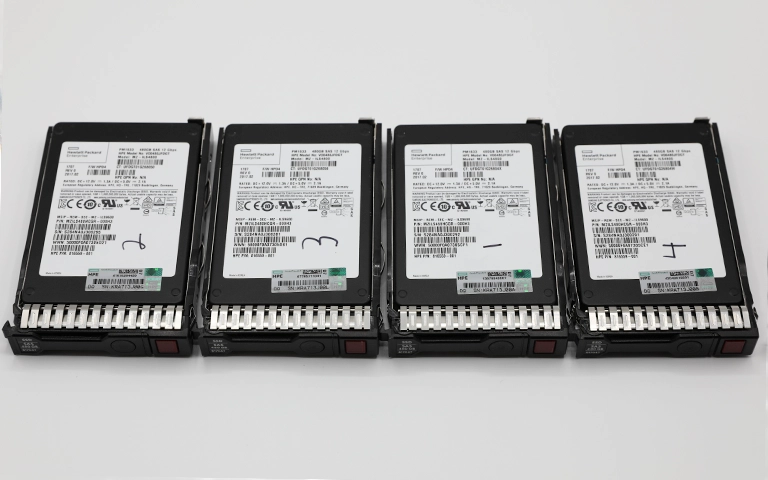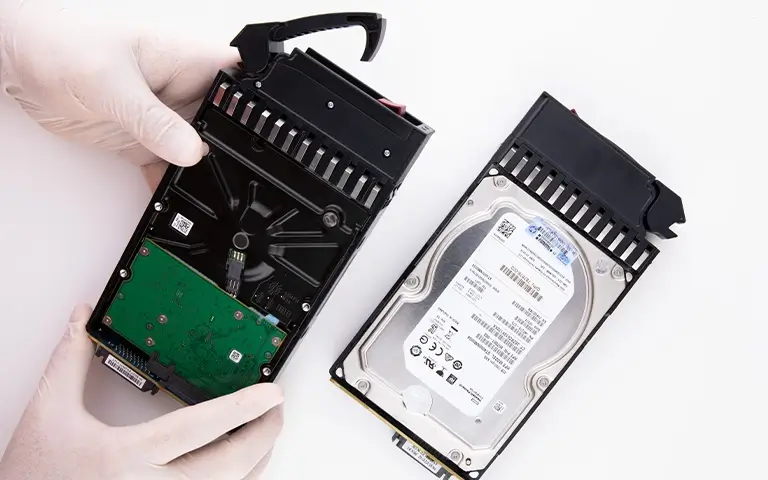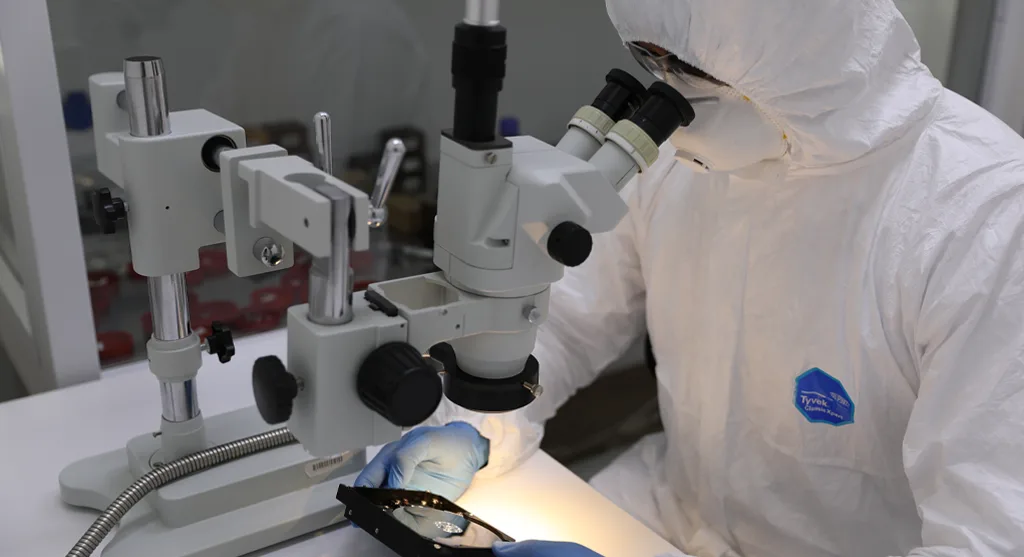RAID 10 is one of the most trusted configurations for businesses that need both speed and data protection. It combines the advantages of RAID 0 and RAID 1, creating a balance between performance and redundancy.
This setup mirrors and stripes data across multiple drives, making it highly reliable for servers, databases, and enterprise environments where uptime is essential. Even if one or more drives fail, the array can continue operating without losing critical data.
In this guide, we’ll explain how RAID 10 works, compare it with other RAID levels, and show how professional recovery services can help when unexpected failures occur.

Fast turnaround times for business-critical data
How RAID 10 Works
RAID 10, also known as RAID 1+0, combines two methods; striping and mirroring. It requires at least four drives, pairing each set into mirrored groups and then striping data across those pairs.
Mirroring (RAID 1) creates an exact copy of the data on two drives, ensuring redundancy. If one drive fails, the mirrored drive keeps the system running without data loss. Striping (RAID 0) then distributes data across mirrored pairs, increasing read and write performance.
This configuration provides both speed and protection, making it ideal for servers that demand fast response times and continuous availability. However, the total usable capacity is only half of the combined storage since half is used for mirroring.
To understand the concept of striping in more detail, check our post What Is RAID 0, which explains how data striping enhances system performance.

RAID 10 vs Other RAID Levels
To understand where RAID 10 stands among other configurations, here’s a simple comparison with RAID 5 and RAID 0, two of the most common alternatives.
For a broader look at parity-based redundancy, you can also read RAID 5 vs RAID 6 to see how these levels compare in data protection and recovery.
Advantages of RAID 10
RAID 10 is often chosen by businesses that value speed and reliability. Its combination of mirroring and striping offers several benefits that make it ideal for demanding storage environments.
Excellent Performance: Data is striped across mirrored drives, providing fast read and write speeds for intensive workloads such as databases and virtual machines.
Strong Fault Tolerance: Each mirrored pair can handle a single drive failure without affecting overall system performance or data integrity.
Fast Rebuild Process: When a failed drive is replaced, only the data from its mirror needs to be restored, reducing rebuild time compared to parity-based arrays.
High Data Reliability: Mirroring ensures every file exists on two drives, significantly lowering the risk of permanent data loss.
Ideal for Mission-Critical Systems: RAID 10 supports continuous uptime, making it suitable for business servers, applications, and real-time databases.
If you’d like to explore more RAID options and how they compare, see Types of RAID for a detailed overview.

Limitations of RAID 10
While RAID 10 provides outstanding performance and reliability, it comes with a few trade-offs that should be considered before deployment.
High Cost of Implementation: RAID 10 requires twice as many drives since half of the total capacity is used for mirroring, increasing hardware costs.
Lower Storage Efficiency: Only 50% of the total disk space is available for use because the remaining capacity is reserved for mirrored copies.
Limited Scalability: Expanding a RAID 10 array can be complex and may require reconfiguration or downtime, depending on the hardware.
No Protection Against Logical Failures: Although it safeguards against physical drive failure, RAID 10 cannot protect against file corruption or accidental deletion.
Dependent on RAID Controller Quality: Performance and reliability depend heavily on the controller’s ability to manage striping and mirroring simultaneously.
For insights into how drive reliability affects RAID systems, check our guide on RAID Failure Rate.
Data Recovery from RAID 10 Arrays
Recovering data from a RAID 10 system requires expertise because of its mirrored and striped architecture. Each drive contributes to both data performance and redundancy, so any damage or misconfiguration can complicate recovery.
When multiple drives fail or the RAID controller becomes unstable, rebuilding the array without professional tools can lead to data overwriting or corruption. That’s why it’s essential to handle the process carefully and avoid manual repairs.
At RAID Recovery Services, our engineers specialize in restoring data from damaged RAID 10 arrays. We identify the original configuration, rebuild the mirrored pairs, and reconstruct the striped structure to extract intact files. Every recovery step is performed in a secure, controlled environment to protect data integrity.
If your RAID 10 array becomes inaccessible or starts showing errors, stop using the system immediately. Continued operation can worsen drive degradation or overwrite recoverable data. For detailed information on safe recovery practices, see Troubleshoot RAID Failure or RAID Controller Failure Recovery.

Is RAID 10 Right for Your Business?
RAID 10 is an excellent choice for organizations that demand both speed and resilience. It delivers top-tier performance for critical workloads such as databases, web servers, and virtualized systems, while ensuring data protection through mirroring.
However, this setup is best suited for businesses that can invest in additional drives and proper maintenance. For smaller operations with limited storage needs or tighter budgets, other RAID levels like RAID 5 or RAID 6 may offer a better balance between cost and redundancy.
When implemented and monitored correctly, RAID 10 provides long-term stability, minimal downtime, and fast recovery after drive failures. But even the most reliable arrays can encounter unexpected issues.
If your RAID 10 system fails or becomes corrupted, our experts can help restore it safely. RAID Recovery Services provides complete diagnostic, repair, and data recovery support for enterprise and server environments.
To learn about potential causes of RAID failures, see Reasons for RAID Data Loss.
If your system experiences drive failure, corruption, or array degradation, contact RAID Recovery Services for an expert assessment and secure data restoration.
Trust the experts with proven results
Frequently Asked Questions
What is RAID 10 used for?
RAID 10 is primarily used in enterprise servers, databases, and high-performance systems where both speed and data protection are essential. It combines mirroring and striping to deliver fast access and strong redundancy.
How many drives are required for RAID 10?
A minimum of four drives is required for a RAID 10 configuration. Two drives are used for mirroring, while the remaining pair provides striping for improved performance.
What happens if one drive fails in RAID 10?
If a single drive fails, its mirrored counterpart keeps the array operational without data loss. The failed drive can be replaced, and the system automatically rebuilds the mirror.
Can RAID 10 fail completely?
Yes. If multiple drives from the same mirrored pair fail before rebuilding, the array can experience data loss. Controller issues, firmware errors, or file corruption can also cause system failure.
How is RAID 10 data recovered after a failure?
Professional recovery involves identifying the correct drive order, rebuilding the mirrors, and reconstructing the striped data. RAID Recovery Services uses specialized tools to safely extract and restore data from failed RAID 10 arrays.